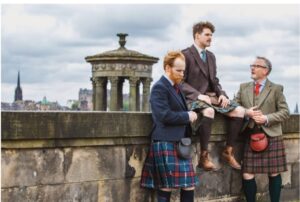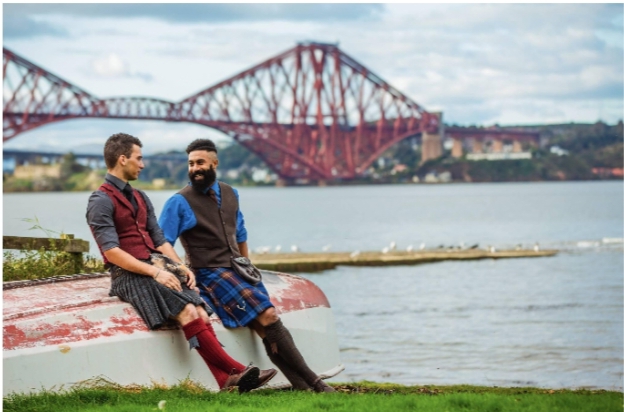Embarking on a ten-day adventure in Scotland promises a journey through some of the most breathtaking landscapes nature has to offer. The rugged highlands, with their majestic mountains and serene lochs, create a dramatic backdrop that captivates the imagination. Traveling through the country, one encounters a rich tapestry of history, marked by ancient castles, standing stones, and charming villages steeped in tradition.
Scotland’s landscapes are not merely a visual feast but also an immersive experience. The air carries the crisp scent of heather, and the sound of bagpipes often echoes through the glens. The ten-day itinerary allows for a comprehensive exploration, from the famous Isle of Skye to the historic Edinburgh Castle. It’s an odyssey that goes beyond the surface, delving into the heart of Scotland’s cultural identity.

As you traverse the landscapes, each turn in the road reveals a new facet of history. Ancient ruins, such as those of Urquhart Castle on the shores of Loch Ness, provide a glimpse into Scotland’s storied past. The well-preserved Culzean Castle on the Ayrshire coast and the mysterious Callanish Standing Stones on the Isle of Lewis add a layer of intrigue to the historical narrative.
Men Kilts: | More Than Clothing, a Sacred National Costume
The kilt, a quintessential symbol of Scottish heritage, takes center stage in this cultural exploration. Beyond being a piece of clothing, the kilt is a sacred national costume that encapsulates the essence of Scottish identity. The House of Edgar, with its production of 80 kilts per week, becomes a crucial player in preserving this cultural legacy.
The kilt is not an isolated garment but part of the Highland Dress, a complete ensemble that embodies tradition and symbolism. Each element, from the specially designed jacket to the sporran strategically placed for practical reasons, contributes to the rich tapestry of Highland Dress. The meticulous craftsmanship involved in creating these garments elevates them to more than mere clothing—they become tangible expressions of cultural pride and heritage.
The Scottish Kilt: Pinnacle of Kilt Production on a Global Scale
As the world’s largest manufacturer of traditional & casual kilts, The Scottish Kilt holds a position of prominence in preserving and disseminating Scotland’s cultural heritage. The staggering production rate of 150+ men kilts per week not only caters to the global highland-wear market but also outfits pipe bands and corporate entities. The House of Edgar’s influence extends far beyond Scotland’s borders, solidifying the kilt as a global symbol of Scottish identity.
The Scottish kilt’s commitment to quality craftsmanship ensures that each kilt produced carries the legacy of centuries of tradition. The global demand for these garments is a testament to the enduring allure of the kilt. It transcends geographical boundaries, appealing to individuals and groups worldwide who seek to connect with the rich cultural tapestry that the kilt represents.
Highland Dress: Beyond the Kilt
Highland Dress, as a complete outfit, weaves together elements that extend beyond the kilt. The jacket, often adorned with intricate details and designed for both formality and functionality, complements the kilt. The belt, socks, shoes, garter ties, and the distinctive kilt pin further enhance the ensemble, creating a visual symphony that resonates with tradition.
Understanding the significance of each component in Highland Dress adds depth to the experience of donning this iconic attire. The sporran, a pouch worn strategically, not only serves a practical purpose but also carries cultural weight, rooted in centuries-old traditions. Embracing Highland Dress is not just about wearing clothes, it’s a symbolic act that connects the wearer to a heritage that spans generations.
Navigating Kilt Wearing Etiquette in Scotland
Wearing a kilt in Scotland is not a mere fashion choice; it’s a cultural norm. However, navigating the nuances of kilt-wearing etiquette is essential to avoid raising eyebrows. The pleats go in the back—an elementary yet crucial tip that aligns the wearer with tradition. Understanding these subtleties adds authenticity to the act of wearing a kilt and fosters a deeper appreciation for the cultural nuances woven into everyday life in Scotland.

In Scotland, a kilt isn’t a costume reserved for special occasions; it’s part of the fabric of daily life. Whether attending a formal event, strolling through the highlands, or enjoying a meal in a local pub, the kilt is a symbol of identity proudly embraced by Scots. The normalization of kilt-wearing underscores its significance as more than a garment—it’s a living tradition, seamlessly integrated into the rhythm of Scottish life.
Tracing Kilts’ Historical Roots: A Glimpse into the Macnaughton’s Legacy
A visit to the Macnaughton, with its 230-year-old legacy on the banks of Loch Tay, provides a fascinating journey into the historical roots of kilts. As a holding company for fabric producers, including The House of Edgar, the Macnaughton stands as a custodian of Scotland’s unique relationship with kilts. Exploring this historical connection unveils the intricate threads that weave together the past, present, and future of this iconic garment.
Macnaughton’s legacy serves as a living history book, recounting the evolution of kilts over centuries. From their humble beginnings as the “Féileadh Mór” or “big wrap” in the 16th century—a versatile woolen cloth adaptable to various uses—to the more refined “Féileadh beag” or “little wrap” following the British Government’s ban on kilts and bagpipes in the 18th century, the Macnaughton’s story mirrors Scotland’s resilience and adaptability.
Evolution of Kilts through History: From “Big Wrap” to “Little Wrap”
The historical evolution of kilts reflects Scotland’s dynamic journey through the centuries. Originating as the “feileadh mór” or “big wrap” in the 16th century, the untailored, thick woolen cloth was a versatile garment adaptable to various weather conditions. Over time, the evolution of kilts took a significant turn with the British Government’s ban on kilts and bagpipes in 1747—a punitive measure after the defeat of Bonnie Prince Charlie.
The ban aimed to suppress Highland identity, leading to the transformation of kilts into the more tailored “Féileadh beag” or “little wrap.” This evolution not only preserved the essence of kilts but also showcased the resilience of Scottish culture in the face of adversity. Understanding this historical context deepens the appreciation for kilts as more than just clothing; they are tangible links to Scotland’s storied past.
From Formal Occasions to Daily Wear:
Kilts were once reserved for formal occasions, weddings, and specific ceremonies. However, today, they have seamlessly integrated into daily wear, symbolizing a shift in perception and acceptance. From the staff of hotels welcoming guests to the fervent supporters of Scotland’s Tartan Army soccer team, plaid clothing is no longer confined to ceremonial events—they are worn with pride in various aspects of life.
The transformation of kilts into everyday attire reflects a broader cultural shift in Scotland. Far from being exclusive to special occasions, kilts have become a dynamic expression of national pride. The Tartan Army’s embrace of kilts, encouraging fans to wear them during matches, exemplifies how this iconic garment has transcended its formal roots to become a symbol of camaraderie and collective identity.
Insights from Macnaughton: Unveiling the Secrets of Kilts
Bill Wheelan from the Macnaughton team provides invaluable insights into the secrets and intricacies of kilts. Addressing questions about the historical significance of kilts, Wheelan sheds light on why they faced a ban in the 18th century. The ban, imposed in 1747 after the defeat of Bonnie Prince Charlie, aimed to suppress Highland identity—a testament to the political and cultural undercurrents woven into the fabric of kilts.
Understanding the historical context adds depth to the appreciation of kilts as symbols of resilience and defiance. The ban, which remained in place until 1783, underscores the challenges faced by Scottish culture and the tenacity with which it clung to its traditions. Bill Wheelan’s insights serve as a bridge between the historical narrative and the contemporary appreciation of kilts as more than just garments.
Technicalities of Kilts: Cost, Fabric & Fitting
Delving into the technicalities of kilts reveals the meticulous craftsmanship involved in their creation. A standard kilt requires 7.4 meters (8 yards) of fabric—a substantial amount that speaks to the garment’s substantial presence. The precision in fitting is emphasized, with the ideal placement of the kilt sitting two fingers above the belly button. These technical details go beyond the surface, offering a glimpse into the artistry required to create a garment that seamlessly combines tradition, functionality, and aesthetic appeal.
The tartan colors, originally representing the fauna of one’s region, served a practical purpose in distinguishing individuals based on their attire. Each clan or region had its distinctive tartan, creating a visual language that spoke to the wearer’s roots. Understanding these technicalities adds a layer of appreciation for the thoughtfulness woven into the very fabric of kilts—a garment that transcends mere fashion to embody a cultural narrative.
The Enduring Question: What Lies Beneath the Kilt?
Amidst the rich tapestry of Scotland’s cultural exploration, the perennial question of what lies beneath the kilt adds a touch of humor and curiosity. Tradition dictates that no undergarments should be worn, reflecting the adherence to age-old customs. However, it has become a personal choice for wearers nowadays, showcasing the dynamic interplay between tradition and individual expression.
The light-hearted inquiry into what lies beneath the kilt serves as a reminder that even in the midst of deep-rooted traditions, there is room for personal choice and individual interpretation. It adds a humanizing element to the discussion, underlining that traditions, while sacred, are not static and can evolve with the times. This playful aspect of the kilt narrative highlights the living, breathing nature of Scottish culture.
In Conclusion: Kilts as a Cultural Legacy
In conclusion, the exploration of kilts in Scotland goes beyond the realm of clothing; it unveils a cultural legacy deeply intertwined with the nation’s history, landscapes, and traditions. From the breathtaking landscapes that provide a canvas for Scotland’s rich history to the meticulous craftsmanship of The House of Edgar, kilts emerge as more than garments—they are living symbols of Scottish identity and pride.
The allure of the kilt lies not just in its aesthetic appeal but in the resilience it represents. From its humble origins as the “Féileadh Mór” to the refined “Féileadh Mór” that emerged after political turmoil, the kilt has weathered storms and stood the test of time. The House of Edgar, with its global production and influence, serves as a custodian of this cultural legacy, ensuring that kilts continue to be woven into the fabric of Scottish identity for generations to come.
As visitors immerse themselves in the landscapes and history of Scotland, the embrace of kilts becomes more than a wardrobe choice—it is a profound connection to a cultural heritage that has shaped the nation’s identity for centuries. The kilt, with its rich history, technical intricacies, and even the playful question of what lies beneath, encapsulates the spirit of Scotland—a nation proud of its past, vibrant in its present, and poised for a future where kilts remain an enduring symbol of cultural legacy.
